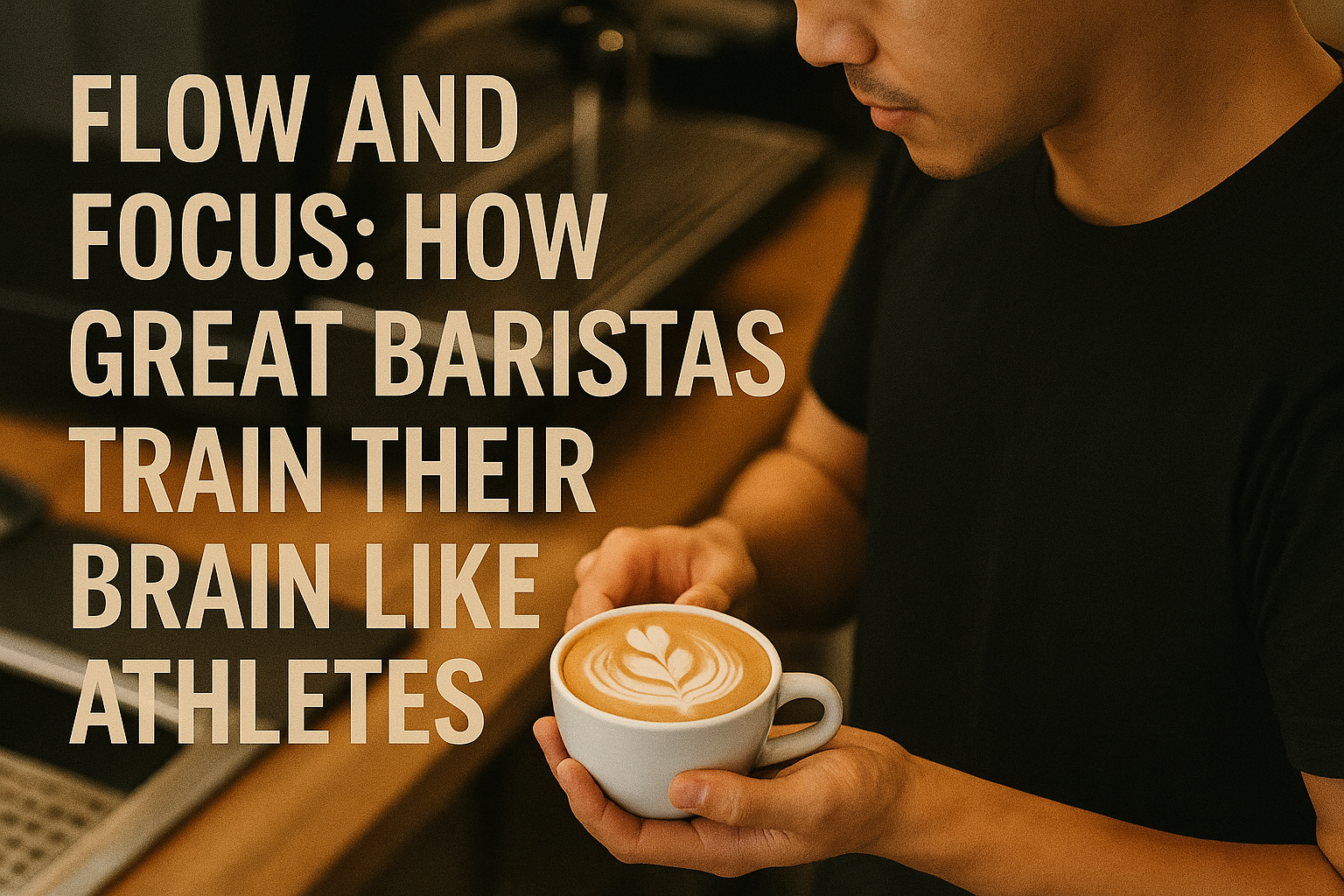The café is loud. The grinder is humming. Orders are coming in fast. A customer wants an oat flat white with extra hot milk. Another just changed their drink mid-shot.
Behind the bar, the best baristas aren’t just making coffee — they’re performing with precision, rhythm, and calm.
This isn’t luck or multitasking magic. It’s the result of mental training, muscle memory, and a deep understanding of flow — the same concepts elite athletes use to stay focused under pressure.
In this article, we dive into how great baristas train their brains like athletes. We explore mental conditioning, focus management, and the unseen skills that separate good baristas from great ones.
Whether you work in a bustling café or dream of competition stages, mastering your mind is as important as dialing in your espresso.
What Is Flow and Why It Matters in Coffee
Flow is a state of deep concentration where you’re fully immersed in what you’re doing. Time feels slower. Your actions feel automatic. Distractions fade. In psychology, it’s known as “optimal experience” — and it’s essential behind the bar.
When a barista enters flow, they move effortlessly. Milk steaming, tamping, and pouring happen in sync. Their body anticipates tasks before their mind catches up. It’s like dance, like sport — but fueled by caffeine and intention.
In high-volume cafés, flow is the difference between stress and control. It allows baristas to work quickly without cutting corners, to improvise when needed, and to stay calm when things go sideways.
Parallels Between Baristas and Athletes
Professional athletes train not only their bodies but also their minds. They visualize, breathe with intention, and stay calm under pressure. Great baristas do the same.
Both roles require:
- Quick decision-making
- Memory under pressure
- Consistency in performance
- Precision in physical movements
- Adaptability to unpredictable situations
The espresso bar is like a sports arena. There are peaks of action, pauses for recovery, team coordination, and personal bests. Understanding this parallel allows baristas to approach their work with the same mental discipline and pride as a professional athlete.
Mental Warm-Ups: Preparing for a Shift Like a Game
Athletes warm up before hitting the field. Baristas should do the same — mentally and physically.
Before each shift, consider:
- Stretching your wrists and shoulders
- Reviewing the menu or new drinks
- Taking a few slow breaths to center yourself
- Visualizing your station, your flow, your first drinks
The best baristas don’t just show up. They tune in. They treat the bar as their arena, the shift as a performance.
This small routine can shift your mindset from reactive to proactive — from chaos to clarity.
The Muscle Memory of Espresso
Just like a tennis player trains their serve until it’s second nature, baristas train every movement.
Tamping, leveling, locking in the portafilter — these actions become instinct through repetition. Pouring milk at just the right angle, reading espresso color in the cup, adjusting grind on the fly — these are skills built through practice, not just knowledge.
Training your hands is as important as training your palate. Muscle memory reduces mental load, allowing you to stay present and react faster during rushes.
Breath and Body Awareness
Elite athletes use breath to regulate stress. So do baristas — even if they don’t realize it.
During peak hours, shallow breathing leads to anxiety and tension. Deep, conscious breathing keeps your nervous system balanced. When you feel pressure rising, try this:
- Inhale slowly through your nose for 4 seconds
- Hold for 2 seconds
- Exhale through your mouth for 6 seconds
Repeat a few cycles while you steam or clean. It’s a micro-reset that helps you stay composed.
Body awareness also matters. Notice where you tense up. Shoulders? Jaw? Adjust your posture. Shake out your hands between drinks. Loosen up. Flow can’t happen in a rigid body.
Managing Cognitive Load
Baristas juggle dozens of tasks in real time — steaming milk, pulling shots, remembering modifiers, managing timers. This is cognitive load. And if unmanaged, it leads to mistakes.
Athletes manage load by automating patterns and reducing decision fatigue. Baristas can do the same.
Use these techniques:
- Prep your station with tools and ingredients in the same place every time
- Batch routine decisions (e.g., same milk order workflow for every drink)
- Minimize distractions (no personal phone, headphones, or side convos during rush)
- Use visual cues (like cup placements or sticky notes for drink mod tracking)
By creating systems and consistency, you free up mental bandwidth — just like a runner perfecting their stride.
Focus Training for Baristas
Baristas often think focus is about trying harder. But like athletes, it’s really about training smarter.
Try these focus-building techniques outside of work:
- Mindful espresso prep: Practice pulling shots in silence, paying full attention to each step
- Timed milk pours: Try to steam, pour, and finish a latte art pour in a set time without rushing
- Distraction drills: Pour latte art with background noise or timers buzzing to simulate café chaos
- Breath focus: Spend 2 minutes each day following your breath — no coffee, no phone, just presence
These habits sharpen your attention. Over time, you’ll find that your focus strengthens just like a muscle.
Recovery and Reset
Athletes understand recovery is part of performance. Baristas often skip it — leading to burnout.
A recovery plan might include:
- A short break after every 2–3 hours of high output
- A hydration routine (coffee dehydrates — balance it)
- Regular stretching or movement outside work
- Quality sleep and nutrition (yes, really)
You can’t pour from an empty cup. Baristas need to recharge to perform consistently — mentally and physically.
Building Team Flow
In sports, flow isn’t just individual. It’s team-based. The same applies behind the bar.
When two or more baristas sync up, they enter a shared rhythm. Drinks move seamlessly. Machines are shared without conflict. No one needs to ask for the milk jug — it’s already been passed.
How to cultivate team flow:
- Communicate non-verbally with gestures or eye contact
- Learn your teammates’ strengths and workstyles
- Switch roles smoothly when needed — no ego
- Debrief after shifts to discuss what worked or didn’t
A team in flow feels effortless. The vibe is electric. Customers feel it too.
Competition-Level Mental Training
Baristas competing in latte art battles or barista championships often feel intense pressure. Mental training becomes even more essential.
Competitors use techniques like:
- Visualization: Mentally rehearsing routines with vivid detail
- Mantras: Phrases like “Calm hands, steady heart” to focus
- Journaling: Recording thoughts post-practice to track progress
- Simulations: Practicing under timed, high-stress conditions
These tools aren’t just for champions. Any barista can adopt them to level up their mental game.
Staying Grounded in the Chaos
Cafés are noisy, unpredictable, and people-driven. They’re also beautiful, alive, and full of potential.
The best baristas are those who stay calm when machines break, who breathe when lines get long, who smile through the foam and the mess.
This isn’t about being perfect. It’s about being present.
Mindset isn’t a luxury. It’s your most important tool.
Final Thoughts: The Inner Craft of Coffee
Behind every perfect pour is a mind that’s trained to see, feel, and move with intention.
Great baristas don’t just pull shots. They pull focus. They breathe through chaos. They learn from athletes — because coffee, like sport, is a performance of discipline and creativity.
So the next time you step behind the bar, ask yourself — how will I train today? Not just my hands, but my mind?
Because flow isn’t a fluke. It’s a skill. And like every skill in coffee, it’s one you can master.

Marcelo Oliveira is a coffee enthusiast and content creator specializing in barista skills, brewing methods, equipment reviews, coffee-related health insights, and fascinating curiosities from the coffee world. With a deep passion for every step of the brewing process, he turns technical knowledge into accessible and engaging content for both beginners and seasoned coffee lovers. Marcelo’s goal is to help readers appreciate the full experience of coffee—from bean to cup.
